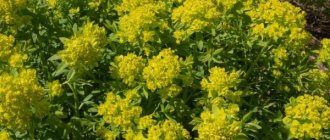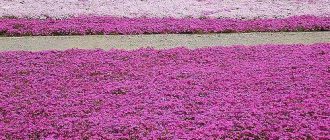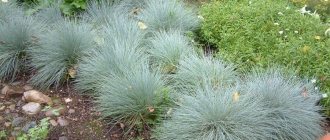Characteristics of dahlias: varieties and varieties
The culture can be roughly divided into annual dahlias (planted in flowerpots to decorate verandas) and perennial dahlias (placed in gardens and flower beds). Each group has its own characteristics, which relate to the principle of planting, appearance and care.
Blooming dahlias
Important! Basically, the difference lies only in the parameters of the aerial parts and buds.
Perennial bushes are very tall and lush. They can grow in one place for more than 2 years. Annuals have miniature forms (usually a low-growing herbaceous base) and are sown as a temporary decoration.
Varieties of varieties
Another difference is the shape of the flower, which determines the main groups of varieties:
- Simple - consist of 1 row of petals and an open center. Outwardly they resemble a colored chamomile. Basic varieties: Princess Marie Jose, Yellow Hammer, Orangeade.
- Anemone-shaped - have several rows of marginal and internal petals. They include varieties such as Lucy, Vera Higgins, Comet.
- Collared - have one row of marginal petals and internal, twisted shape. Varieties: La Gioconda, Chimborazo, Claire de Luna.
- Peony-shaped. The name fully matches the appearance. The most popular varieties are: Symphonia and Fascination.
- Decorative group - represented by varieties David Howard, Thames Valley, Jocondo.
- Globular - Crichton Honey, Doreen Hayes and Esmonde.
- Pom-poms - differ in different colors, among which there is only a blue tint. Varieties: Hallmark, Willo's Violet and Noreen.
- Cactaceae – Visit, Danny, Pirouette, Doris Day.
- Semi-cactus – Yellow Mood, White Swallow, Nantenan, Autumn Fire.
- Nymphaeaceae - they are also called lotus-shaped because of their resemblance to the flower of the same name. Main varieties: Gery Hawk, Genette and Brushstrokes.
Annual varieties
The mixed group has the largest number of different varieties.
Planting a plant
Dahlias, planted and cared for according to a simple scheme, bloom almost all summer until late autumn. To achieve a riot of colors, it is important to plant flowers correctly.
Planting by seeds
Dahlias Cheerful guys - planting and care
Mostly annual dahlia is planted with seeds. This herbaceous plant has a neat above-ground part. The trunk reaches 30-40 cm in height. Such hybrids bloom profusely and for a long time and are suitable for growing in flowerpots.
Note ! There are two options for sowing: in open soil and in pots with further planting in a flower bed. The first one is more popular, since the seedlings are resistant to adverse weather conditions.
Germination of seeds
How to plant dahlias with seeds:
- Choosing a location. The culture is sun-loving, so it should be placed in an open area.
- Sowing is carried out in May. The plant loves warmth, so you need to focus on the weather.
- Land preparation. It is worth choosing loamy soil. Slightly acidic or neutral soil is suitable. You must first add compost and mineral fertilizers.
- Soaking seeds. They need to be soaked in a fungicide solution to protect them from disease and rot.
- On a flat area, make grooves 2-3 cm deep at a distance of 30-40 cm from each other.
- Place the seeds along the groove at a distance of 30-40 cm. Sprinkle the planting material with soil and water.
- To speed up germination, the bed should be covered with film or glass. When the first shoots appear after 2-3 weeks, the shelter is removed.
Sprouted seedlings
When sowing seeds in a container, the algorithm of actions is the same. True, planting can begin in March-April, since germination will be carried out in greenhouse conditions or indoors.
Planting seedlings
When planting seedlings, you need to choose exclusively sunny areas, but protected from drafts and wind. The soil must be fertilized in advance and well loosened. Sprouts are planted in late May or early June.
The process of planting seedlings:
- Prepare the wells. The depth and width should correspond to the size of the root system of the seedling. The distance between the recesses must be at least 40 cm.
- Lay the sprouts horizontally and dig in so that the root collar is covered with 3-5 cm of soil.
- Water the seedlings generously.
- Cover with film until the temperature at night stops dropping below 10 °C.
Seedlings in open ground
The flower grows quickly, so you need to constantly monitor the height of the film. Otherwise, the trunks will be deformed and will be located horizontally in relation to the ground.
What to do with dahlias in the fall
Dig for storage
Dahlias are heat-loving plants that cannot tolerate low temperatures at all, so they must be dug up for the winter.
It is not recommended to start digging if the leaves of the plant are still green and flowering continues, but you should not wait for severe frosts either. 15-20 days after pruning, the tubers ripen and can be dug up.
The optimal time for digging up tubers depends on the region of growth.:
- southern regions - late October-early November;
- in the middle zone - mid-October;
- in the Urals - the end of September - the first days of October;
- in Siberia - September.
Leave it to overwinter in the garden
In the southern regions, the practice is to leave the tubers to overwinter in the ground. Extremely low temperatures range from -5 to -7 degrees. The leaves and stems of dahlias are cut and removed from the flower garden, the soil is covered with a layer of mulch from pine branches or bark, 5-10 cm thick.
Most gardeners, even from warm regions, are afraid of unfavorable weather conditions and prefer to dig up dahlia tubers.
Watering and loosening the soil
Garden azalea - planting and care in open ground
Caring for dahlias after planting consists of watering the plant and loosening the soil. How to do it correctly:
- When the above-ground part is 10-12 cm high, hilling needs to be done. Form a slide around the trunk. This will help it take root better by sending out additional shoots.
- Watering is carried out once a week, because the crop is drought-resistant. The ground should get wet 30 cm deep. Artificial watering is stopped from mid-August.
- After each watering, you need to renew the hill around the trunk and loosen the soil in the hole. This will help protect the root system from rotting and provide a normal supply of oxygen.
Watering the plant
Note! Hilling is carried out several times per season. The need arises when the position of the bush relative to the ground changes.
To prevent the soil from drying out, you can lay mulch in the hole. But you shouldn’t get carried away - the layer should be minimal. Periodically, you need to remove the mulch to ventilate and loosen the soil.
In addition to watering and caring for the soil, an important rule is the formation of supports for the bushes. The basis for the tether is driven into the ground when planting the seedlings. Do not forget about trimming excess branches and leaves.
How often to water perennial dahlias after planting in open ground?
There is often no need to water the plant. Watering once every 14 days is considered optimal. If the summer is dry, it is allowed to water the soil once every 10 days. The fact is that the root system of dahlias is shallow, but consists of bulbs. Therefore, with a large amount of moisture, they can begin to rot. Therefore, the plant's growth will stop and you will not receive bulbs to plant next year.
Immediately after planting, watering is carried out every day for a week. This helps roots and bulbs take root and stimulates growth.
Watering dahlias
Reproduction methods
Sill planting and care in open ground
Dahlia can reproduce in five ways. Each option has advantages and disadvantages, and some are used extremely rarely. Methods of propagation of culture:
- Dividing tubers. The simplest option that will allow you to preserve all the qualities of the mother bush. In the fall, you need to remove the tubers from the ground, wash them, remove dead roots and separate the tubers with your hands. As a result of division, each tuber should have two buds left.
- Vaccination is an infrequent, but very effective type of propagation. Make a conical hole in an old tuber. Sharpen a healthy dahlia sprig and insert it into the tuber. Wrap the joint with cotton wool. Plant the graft into the ground.
- Sowing seeds. This propagation option allows you to get a completely new plant (maternal characteristics are not preserved). When the flower begins to fade, you need to cut it and dry it indoors. Next, the planting material is collected and packaged until spring.
- Cuttings. The method makes it possible to obtain strong plants with high resistance to disease. At the beginning of March, healthy tubers are planted in a box. Proper watering and maintenance is carried out. When the tubers grow, a cutting will appear. After 2-3 internodes appear on the cutting, it can be cut off. Place the sprout in a container with sand.
- Disputes make it possible to obtain a new variety. Cut off a flowering branch and plant in a separate pot. Gradually reduce watering and let the branch dry out. For the winter, place the container in a room with a temperature of 6 °C. In the spring, resume watering in order to plant the bush in open ground in May.
Reproduction methods
Thanks to different propagation methods, it is possible to obtain not only a large number of young bushes, but also completely new varieties.
Features of growing dahlias from tubers
This is the most common method of propagating and growing perennial dahlias. Their rhizomes consist of several tubers fused at the stem. In some varieties they are elongated and thin, like carrots, in others they are round, like potatoes.
The dahlia rhizome consists of several tubers fused with root collars.
These tubers are juicy and fragile. Hence the features and disadvantages of growing:
- Protect rhizomes from mechanical damage that they may receive during digging, transportation, germination, division, and planting.
- Treat each wound on tubers with an antiseptic or fungicide to prevent possible infection with rot and other fungi.
- Avoid over-moistening and drying out. In the first case, the tubers rot, in the second, they wither and mummify.
- Both the roots and shoots of this plant are afraid of frost, which significantly shortens the growing season. Therefore, be sure to germinate dahlia tubers before planting.
However, propagating dahlias by rhizomes is still easier and more reliable than by cuttings, grafting or seeds. Inside each juicy tuber a supply of nutrition and moisture is stored. If there is at least one bud on it, then a shoot will definitely grow and it will bloom this year. The flowers will have all the characteristics of the variety to which they belong.
Feeding and fertilizers
In order for the bush to bloom luxuriantly and not be attacked by pests, periodic feeding must be done during the growing season. Do the procedure at least 2 times a month. In order for the plant to receive all the necessary substances, you need to alternate the use of mineral and organic fertilizers.
Infusions of mullein, chicken droppings, and ammonium nitrate are used as organic fertilizers. The bush will grow to full size if you add superphosphates or potassium fertilizers when the first two buds appear. You also need to plant the sprouts in well-fertilized soil. It is important not to overdo it with fertilizers, so as not to destroy the flower.
Transplanting a plant
The plant needs to be replanted every 3 years or completely replace the soil in the hole. This will help protect the plant from diseases and pests. The ideal time for the procedure is spring. The root system has not yet entered the active growth stage, so there will be no problems with rooting in the future.
Additional Information. Before planting dahlias in a new place, you need to prepare a hole. It is advisable to do this in the fall.
For transplantation you need:
- Dig up the tuber and treat the roots.
- Soak the transplanting material in an antiseptic or wash off the old soil.
- Move to a new hole and dig in.
- Water the transplanted plants.
Transplanting a plant
How to form a bush correctly
One of the necessary actions for caring for dahlias is the correct formation of the bush and the timely removal of faded buds. If you do not carry out these actions, then new buds on the flower will appear more slowly and the bush itself will begin to develop more slowly. To get healthy dahlias, you need to leave 3 main branches with flowers.
After planting, the flower adapts to the new environment for some time, after which it enters a phase of rapid growth. During this period, the main stems are identified, and the rest must be removed. This will help avoid heavy overgrowth of the bush.
The main stems continue to grow and over time they form stepchildren. They also need to be removed to remove excess load from the flower. It is necessary to pinch from the beginning of active flower growth until the ovaries appear on the bush.
In order to grow dahlias tall and strong, it is necessary to remove the lower leaves to a height of 30-40 cm from the ground. This will ensure a full supply of air to the flower and root, as well as light, and in the future, because of this procedure, the tubers will more easily endure the winter.
Pruning Dahlia
In order for the bushes to have huge flowers of bright colors, you need not only to constantly take care of feeding, but also to be able to shape the bush. Pruning is the most effective option:
- A maximum of three stems are left in the bush.
- Excess buds are plucked off the peduncles, leaving only 1-2.
- Withered and faded buds are also removed.
- In tall varieties, the side branches are also pruned.
The formation of the bush continues all summer, from the moment the flower stalks appear until late autumn. Additionally, the bushes need to be tied up and secured to a support.
How to properly divide and process dahlia tubers for planting?
It is necessary to properly divide and prepare the tubers. The most interesting thing is that after you have just pulled the tubers out of the cellar, you need to cut them into pieces. And this is done in a certain way.
Instructions:
- It is necessary that each part has a bud and a root collar.
- All cuts must be dried and sprinkled with charcoal or ash. It is necessary to understand that no more than 2 buds should be left per onion.
- If there are more buds, you will get more branching with a small number of small flowers.
- There is an opinion that the tuber should be divided into a maximum of 5 parts. It all depends on its size and number of buds.
Some gardeners cut tubers in the fall, but many experienced bloggers recommend doing this in the spring, just a week or two before planting.
Dahlia tubers
Pests and diseases
Proper care, timely watering and fertilizing prevent pests from appearing, but sometimes they still overtake the plant. The gardens with such flowers are most often visited by slugs and earwigs.
To protect the bushes on hot days, they are sprayed with insecticidal preparations. This will help protect leaves and flowers from caterpillars, thrips, and mites.
Problems with leaves
Most of all, dahlias are bothered by aphids, which inhabit the rosettes of leaves and are located on the stems and the back of the leaf blade. You can escape from the pest only by using a soap solution as a sprayer.
Flowering period and care during this period
Dahlia flowers are not only beautiful, but also demanding. During the flowering period, the plant needs special attention.
How to care for dahlias during the flowering period:
- Double the amount of watering.
- Remove faded buds and dry leaves.
- Pick off excess buds on the flowering cluster.
- Fertilize with organic fertilizers.
Flowering culture
Other needs may arise due to the characteristics of the variety.
Preparing for winter
In September the stems begin to wilt and change color after the first frost. This is the perfect time to clean.
To prepare a flower for wintering, you need:
- Cut off the stems. Dig up the root.
- Remove excess soil from the tubers, wash them and dip them in a solution of potassium permanganate for 30 minutes.
- Find wilted shoots and cut them off. Sprinkle the sections with activated carbon powder.
- Dry the tubers and put them in wooden boxes. Place the crop in a room where the temperature does not exceed 10 °C.
- If the winter is harsh, then the roots are left in the same room. If the frosts are not severe, then you can take the boxes to the cellar or barn.
Tuber storage
If sprouts appear on the roots, you need to know how to preserve the sprouted dahlia until planting. To do this, you need to pour sawdust into the box and cover the container with a cloth.
Use in landscape design
Dahlia is a very beautiful and bright flower, so it is actively used in landscape design. Flowers are planted in flower beds, formed into flower beds, and used to create hedges.
Landscape use
The culture goes well with almost any tall flowers and shrubs. Annual varieties can be planted in flowerpots to decorate areas and open spaces. So the dacha will be full of different colors, which will change from mid-summer to the end of September.
Beautiful bush of dahlias
Growing dahlias, as well as their propagation, are simple procedures. The culture is very unpretentious and adapts perfectly to any conditions. But in order to achieve lush flowering, the plant needs to be given more attention: feeding, irrigating and watering.
Basic growing conditions
Dahlias are beautiful flowers and very easy to care for, which is why they have earned the love of many florists. The basic rules for growing them are in the following conditions:
- Properly selected location (slightly shaded area on the western side, with deep groundwater).
- A high-quality soil mixture (weakly acidic soils such as light loams and fertile black soil are ideal for the plant; wood ash powder or common lime will help reduce high acidity).
- Compliance with watering conditions (too much moisture contributes to the rotting of tubers, and frequent droughts lead to the death of the flower). It is also important not to use regular tap water, as it is too hard and can harm the plants. Let's look at how to prepare water and how to water dahlias correctly in more detail.











